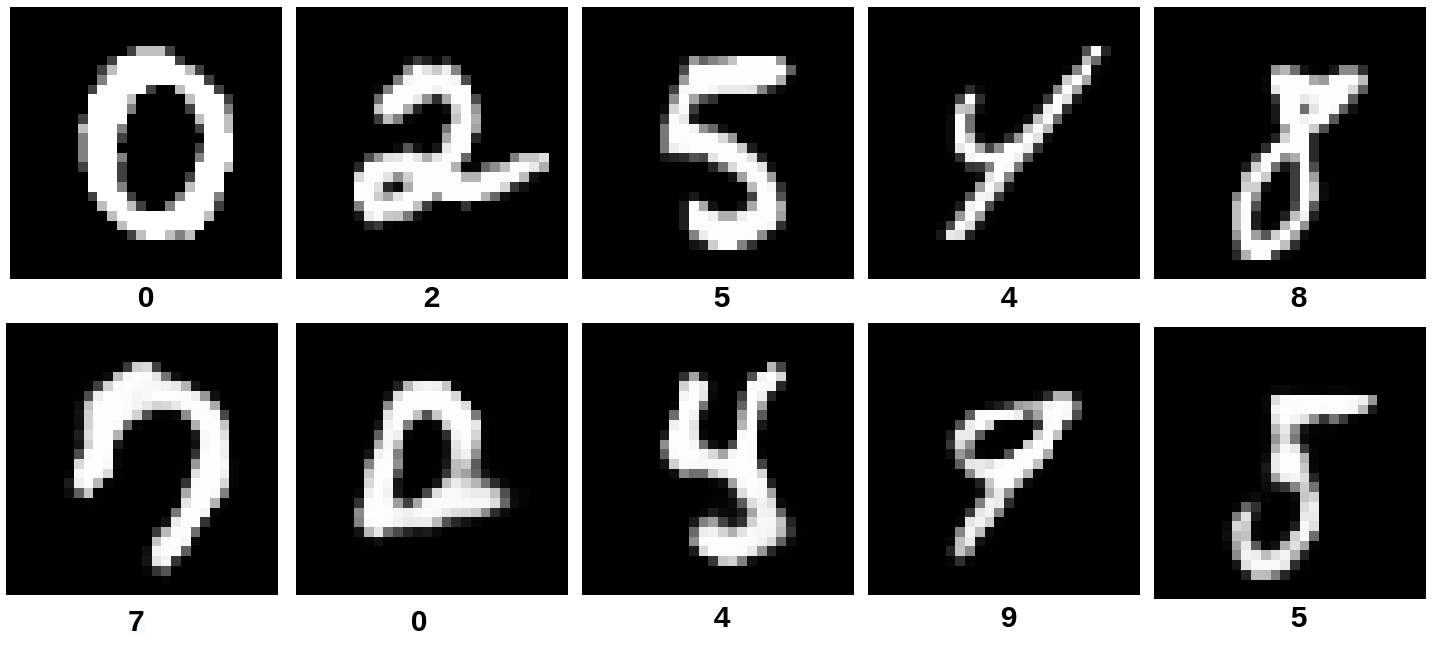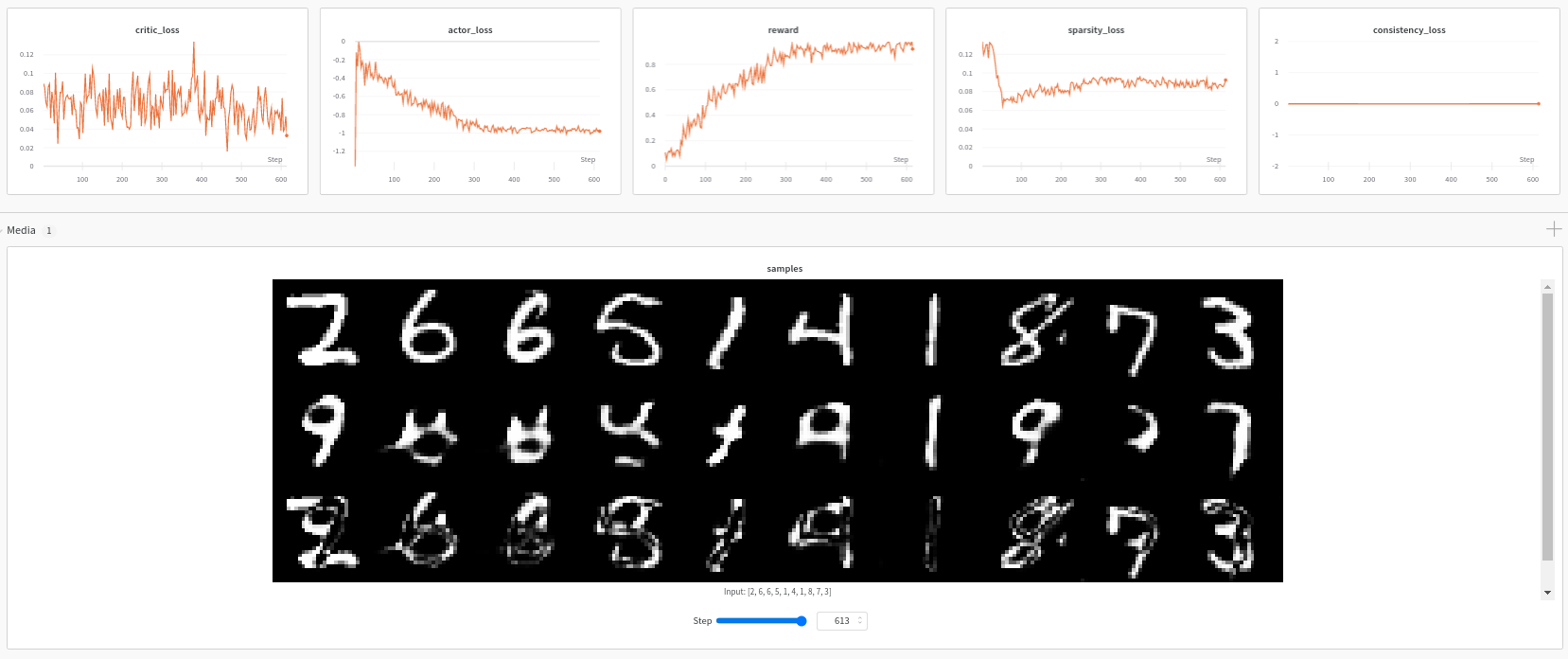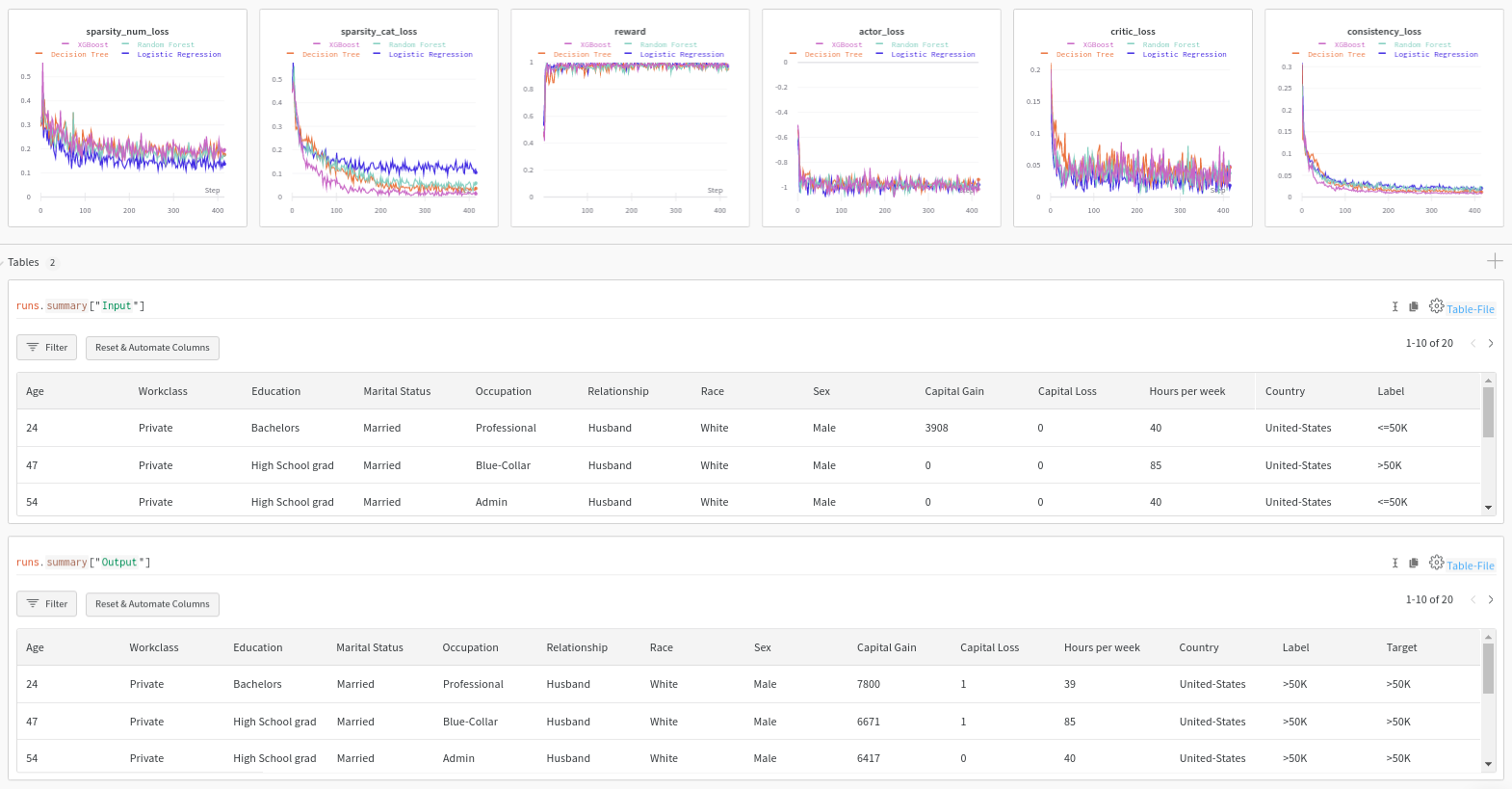This page was generated from methods/CFRL.ipynb.
Counterfactuals with Reinforcement Learning
Note
To enable support for Counterfactuals with Reinforcement Learning, you need one of tensorflow or torch installed. You can do so using:
pip install alibi[tensorflow]
or
pip install alibi[torch]
Overview
The counterfactual with reinforcement learning is based on the Model-agnostic and Scalable Counterfactual Explanations via Reinforcement Learning which proposes a fast, model agnostic method to generate batches of counterfactual explanations by replacing the usual optimization procedure with a learnable process. The method does not assume model differentiability, relies only on the feedback from the model predictions, allows for target-conditional counterfactual instances and flexible feature range constraints for numerical and categorical features, including the immutability of protected features (e.g, gender, race). Furthermore, it is easily extendable to multiple data modalities (e.g., images, tabular data).
Counterfactual instances (a.k.a. counterfactual explanations, counterfactuals) are a powerful tool to obtain insight into the underlying decision process exhibited by a black-box model, describing the necessary minimal changes in the input space to alter the prediction towards the desired target. To be of practical use, a counterfactual should be sparse—close (using some distance measure) to the original instance—and indistinguishable from real instances, that is, it should be in-distribution. Thus, for a loan application system that currently outputs a rejection for a given individual, a counterfactual explanation should suggest plausible minimal changes in the feature values that the applicant could perform to get the loan accepted leading to actionable recourse.
A desirable property of a method for generating counterfactuals is to allow feature conditioning. Real-world datasets usually include immutable features such as gender or race, which should remain unchanged throughout the counterfactual search procedure. A natural extension of immutability is to restrict a feature to a subset or an interval of values. Thus, following the same loan application example, a customer might be willing to improve their education level from a High-school graduate to Bachelor’s or Master’s, but not further. Similarly, a numerical feature such as age should only increase for a counterfactual to be actionable. To enable such feature conditioning, we propose to use a conditioning vector to guide the generation process.
A counterfactual explanation of a given instance represents a sparse, in-distribution example that alters the model prediction towards a specified target. Let \(x\) be the original instance, \(M\) a black-box model, \(y_M = M(x)\) the model prediction on \(x\) and \(y_T\) the target prediction. The goal is to produce a counterfactual instance \(x_{CF} = x + \delta_{CF}\) where \(\delta_{CF}\) represents a sparse perturbation vector such that \(y_T = M(x_{CF})\). Instead of solving an optimization problem for each input instance, we train a generative model which models the counterfactual instances \(x_{CF}\) directly and allows for feature level constraints via an optional conditioning vector \(c\). A conditional counterfactual explanation \(x_{CF}\) therefore depends on the tuple \(s = (x, y_M, y_T, c)\).
The method does not assume the model \(M\) to be differentiable and it trains the counterfactual generator using reinforcement learning, namely Deep Deterministic Policy Gradient (DDPG). DDPG interleaves a state-action function approximator called critic (\(Q\)), with learning an approximator called actor(\(\mu\)) to predict the optimal action, which is equivalent to predicting the optimal counterfactual. The method assumes that the critic is differentiable with respect to the action argument, thus allowing to optimize the actor’s parameters efficiently through gradient-based methods.
This model-agnostic training pipeline is compatible with various data modalities and only uses sparse model prediction feedback as a reward. For a classification model returning the predicted class label the reward can be defined by an indicator function, \(R = 1(M(x_{CF}) = y_{T})\). The reward for a regression model, on the other hand is proportional to the proximity of \(M(x_{CF})\) to the regression target \(y_T\).
Instead of directly modeling the perturbation vector \(\delta_{CF}\) in the potentially high-dimensional input space, we first train an autoencoder. The weights of the autoencoder are frozen and \(\mu\) applies the counterfactual perturbations in the latent space of the encoder. The pre-trained decoder maps the counterfactual embedding back to the input feature space. Since \(\mu\) operates in the continuous latent space we use the sample efficient DDPG method. We denote by \(enc\) and \(dec\) the encoder and the decoder networks, respectively. Given the encoded representation of the input instance \(z = enc(x)\), the model prediction \(y_M\), the target prediction \(y_T\) and the conditioning vector \(c\), the actor outputs the counterfactual’s latent representation \(z_{CF} = \mu(z, y_M, y_T, c)\). The decoder then projects the embedding \(z_{CF}\) back to the original input space, followed by optional post-processing.
The training step consists of simultaneously optimizing the actor and critic networks. The critic regresses on the reward \(R\) determined by the model prediction, while the actor maximizes the critic’s output for the given instance through \(L_{max}\). The actor also minimizes two objectives to encourage the generation of sparse, in-distribution counterfactuals. The sparsity loss \(L_{sparsity}\) operates on the decoded counterfactual \(x_{CF}\) and combines the \(L_1\) loss over the standardized numerical features and the \(L_0\) loss over the categorical ones. The consistency loss \(L_{consist}\) aims to encode the counterfactual \(x_{CF}\) back to the same latent representation where it was decoded from and helps to produce in-distribution counterfactual instances. Formally, the actor’s loss can be written as: \(L_{actor} = L_{max} + \lambda_{1}L_{sparsity} + \lambda_{2}L_{consistency}\)
Tabular

Samoilescu RF et al., Model-agnostic and Scalable Counterfactual Explanations via Reinforcement Learning, 2021
In many real-world applications, some of the input features are immutable, have restricted feature ranges, or are constrained to a subset of all possible feature values. These constraints need to be taken into account when generating actionable counterfactual instances. For instance, age and marital status could be features in the loan application example. An actionable counterfactual should however only be able to increase the numerical age feature and keep the categorical marital status feature unchanged. To achieve this we condition the counterfactual generator on a conditioning vector \(c\).
Following the decoding phase, as part of post-processing (denoted by a function \(pp\)), the numerical values are clipped within the desired range, and categorical values are conditionally sampled according to their masking vector. This step ensures that the generated counterfactual respects the desired feature conditioning before passing it to the model. Note that CFRL is flexible and allows non-differentiable post-processing such as casting features to their original data types (e.g., converting a decoded floating-point age to an integer: 40 = int(40.3)) and categorical mapping (e.g., marital status distribution/one-hot encoding to the married value) since we rely solely on the sparse model prediction reward.

Samoilescu RF et al., Model-agnostic and Scalable Counterfactual Explanations via Reinforcement Learning, 2021
Counterfactual diversity is important since it allows the user to take an informed action subject to personal preferences. CFRL can be extended to generate diverse counterfactuals too. Note that the deterministic decoding phase ensures consistency over repeated queries but limits the output to a single possible counterfactual per instance. To increase the diversity, we can sample the conditional vector subject to the user-defined feature constraints. Thus, for unconstrained features, we follow the same sampling procedure applied during training, while for constrained ones, we sample a subset of their restricted values which ensures the feasibility of the counterfactual.
Images

Samoilescu RF et al., Model-agnostic and Scalable Counterfactual Explanations via Reinforcement Learning, 2021
CFRL is a flexible method and can be easily extendable to other data modalities, such as images. The training pipeline remains unchanged and only requires a pre-trained autoencoder for each dataset. The method can generate valid, in-distribution counterfactuals even for high-dimensional data.
Usage
CFRL provides a base class specifically designed to be easily adaptable to multiple data modalities. CFRL achieves this flexibility by allowing the user to input custom functions as:
reward_func- element-wise reward function.conditional_func- generates a conditional vector given a input instance.postprocessing_funcs- post-processing list of functions. Non-differentiable post-processing can be applied.
For more details, see the documentation here.
Image
We first introduce the image dataset scenario due to ease of usage.
Predictor
Since CFRL works on black-box models, only access to a predict function is needed. The model below is a simple convolutional neural network(CNN) trained on the MNIST dataset:
predictor = lambda x: cnn(x)
Note that for the classification task the CFRL expects the output of the predictor to be a 2D array, where the second dimension matches the number of classes. The output can be either soft-label distribution (actual probabilities/logits for each class) or hard-label distribution (one-hot encoding). Regardless of the output prediction (logits, probabilities, one-hot encoding), for the classification task the CFRL applies the argmax operator on the output.
Autoencoder
CFRL models the perturbation vector \(\delta_{CF}\) in embedding space, thus a pre-trained autoencoder, ae, is required. The autoencoder is a CNN trained on the MNIST dataset, and for simplicity of notation we assume that the model can be factored out in two components, ae.encoder and ae.decoder, corresponding to the encoder component and decoder component, respectively.
Initialization
explainer = CounterfactualRL(predictor=predictor,
encoder=ae.encoder,
decoder=ae.decoder,
coeff_sparsity=COEFF_SPARSITY,
coeff_consistency=COEFF_CONSISTENCY,
latent_dim=LATENT_DIM,
train_steps=300000,
batch_size=100,
backend="tensorflow")
where:
predictor- black-box model.encoder- pre-trained encoder.decoder- pre-trained decoder.latent_dim- embedding/latent dimension.coeff_sparsity- sparsity loss coefficient.coeff_consistency- consistency loss coefficient.train_steps- number of training steps.batch_size- batch size dimension to be used.backend- backend to be used. Possible values:tensorflow|pytorch.
We previously mentioned the CFRL base class can be easily adaptable to multiple data modalities, by allowing the user to specify custom functions. By default, the customizable functions are defined as:
reward_func- by default, checks if the counterfactual prediction label matches the target label.conditional_func- by default, the function returnsNonewhich is equivalent to no conditioning.postprocessing_funcs- by default is an empty list which is equivalent to no post-processing.
Fit
Fitting is straightforward, just passing the training set:
explainer.fit(X=X_train)
Explanation
We can now explain the instance:
explanation = explainer.explain(X=X_test,
Y_t=np.array([1]),
batch_size=100)
where:
X- test instances to be explained.Y_t- target class. This array can contain either a single entrance that is applied for all test instances or multiple entrances, one for each test instance.batch_size- batch size to be used at prediction time.
The explain method returns an Explanation object with the following attributes:
"orig"- a dictionary containing the following key-value pairs:"X"- original input instances."class"- classification labels of the input instances.
"cf"- a dictionary containing the following key-value pairs:"X"- counterfactual instances."class"- classification labels of the counterfactual instance.
"target"- target labels."condition"- counterfactual conditioning.
Tabular
The tabular scenario follows closely the details provided for the image one, by replacing the custom functions to match the CFRL original implementation.
Predictor
As previously mentioned, CFRL operates in the black-box scenario and thus it can be applied to any model (from differentiable models as neural networks to highly non-differentiable models such as Decision Tree, Random Forest, XGBoost, etc.). The predictor can be defined as:
predictor = lambda x: black_box.predict_proba(x)
For classification, the output has to respect the same conventions as described in the Image section, namely to be a 2D array having the second dimension match the number of classes.
Note that for models that do not support predict_proba which outputs the distribution over the classes, one can write a custom function that returns a one-hot encoding representation of the label class without affecting the performance since CFRL applies the argmax operator over the output distribution.
Heterogeneous autoencoder
For the heterogeneous autoencoder, heae, we use the same naming convention as for Image datasets and assume that the autoencoder can be factored into two independent components, heae.encoder and heae.decoder, representing the encoder and decoder modules. For the tabular scenarios, both the encoder and decoder networks can be fully connected networks.
Since we are dealing with a heterogeneous dataset, that has to be reflected in the output of the decoder. Thus, the convention is that the decoder must be a multiheaded network which implies that the output must be a list of tensors. The first head models all the numerical features (if exist), while the rest of the heads model the categorical ones (one head for each categorical feature).
Heterogeneous datasets require special treatment. In this work, we modeled the numerical features by normal distributions with constant standard deviation and categorical features by categorical distributions. Due to the choice of feature modeling, some numerical features can end up having different types than the original numerical features. For example, a feature like Age having the type of int can become a float due to the autoencoder reconstruction (e.g., Age=26 -> Age=26.3).
This behavior can be undesirable. Thus we performed a casting when processing the output of the autoencoder (decoder component).
We can specify the datatype of each numerical feature by defining:
feature_types = {"Age": int, "Capital Gain": int, "Capital Loss": int, "Hours per week": int}
(by default each numerical feature is considered to be float, thus it can be omitted from the feature_types dictionary).
Then we can obtain a heterogeneous autoencoder pre-processor(heae_preprocessor) which standardizes the numerical features and transforms the categorical one into a one-hot encoding. The pre-processor is accompanied by an inverse pre-preprocessor(heae_inv_preprocessor), designed to map the raw output of the decoder back to the original input space. The inverse pre-processor includes type casting specified in the feature_types.
We can obtain the pre-processing pair by:
from alibi.explainers.backends.cfrl_tabular import get_he_preprocessor
heae_preprocessor, heae_inv_preprocessor = get_he_preprocessor(X=X_train,
feature_names=adult.feature_names,
category_map=adult.category_map,
feature_types=feature_types)
Constraints
A desirable property of a method for generating counterfactuals is to allow feature conditioning. Real-world datasets usually include immutable features such as gender or race, which should remain unchanged throughout the counterfactual search procedure. Similarly, a numerical feature such as age should only increase for a counterfactual to be actionable.
We define the immutable features as:
immutable_features = ['Marital Status', 'Relationship', 'Race', 'Sex']
and ranges for numerical attributes as:
ranges = {'Age': [0.0, 1.0], 'Hours per week': [-1.0, 0.0], "Capital Gain": [-1.0, 1.0]}
The encoding for ranges has the following meaning:
"Age"- can only increase."Hours per week"- can only decrease."Capital Gain"- can increase or decrease. It is equivalent of saying that there are no constraints, and therefore can be omitted.
Note that the value 0 must be contained in the specified interval. For more details, see the documentation here.
Initialization
explainer = CounterfactualRLTabular(predictor=predictor,
encoder=heae.encoder,
decoder=heae.decoder,
latent_dim=LATENT_DIM,
encoder_preprocessor=heae_preprocessor,
decoder_inv_preprocessor=heae_inv_preprocessor,
coeff_sparsity=COEFF_SPARSITY,
coeff_consistency=COEFF_CONSISTENCY,
feature_names=adult.feature_names,
category_map=adult.category_map,
immutable_features=immutable_features,
ranges=ranges,
train_steps=100000,
batch_size=100,
backend="tensorflow")
where:
decoder - heterogeneous decoder network. The output of the decoder must be a list of tensors.
encoder_preprocessor - heterogeneous autoencoder/encoder pre-processor.
decoder_inv_preprocessor - heterogeneous autencoder/decoder inverse pre-processor.
category_map - dataset category mapping. Keys are feature indexes and values are list feature values. Provided by the alibi dataset.
feature_names - list of feature names. Provided by the alibi dataset.
ranges - numerical feature ranges, described in the previous section.
immutable_features - list of immutable features, described in the previous section.
The rest of the arguments were previously described in the Image section.
Fit
Similar to the Image section, fitting is straight-forward, just passing the training set:
explainer.fit(X=X_train)
Explanation
Before asking for an explanation, we can define some conditioning:
C = [{"Age": [0, 20], "Workclass": ["State-gov", "?", "Local-gov"]}]
The above condition is equivalent to say that the Age is allowed to increase up to 20 years and that the Workclass can change to either "State-gov", "?", "Local-gov" or remain the same. Note that the conditioning is expressed as a \(\delta\) change from the input and the original feature value will be included by default.
We can generate an explanation by calling the explain method as follows:
explanation = explainer.explain(X=X_test,
Y_t=np.array([1]),
C=C,
batch_size=BATCH_SIZE)
where:
C- conditioning. The list can contain either a single entrance that is applied for all test instances or multiple entrances, one for each test instance.
The rest of the arguments were previously described in the Image section.
The explain method returns an Explanation object described as well in the Image section.
Diversity
We can generate a diverse counterfactual set for a single instance by calling the explain method and by setting the diversity=True:
explanation = explainer.explain(X=X_test[0:1],
Y_t=np.array([1]),
C=C,
diversity=True,
num_samples=NUM_SAMPLES,
batch_size=BATCH_SIZE)
where:
diversity- diversity flag.num_samples- number of distinct counterfactual instances to be generated.
The rest of the arguments were previously described in the Image section.
Possible corner case
As we previously mention, tabular scenario requires a heterogeneous decoder. That is a decoder which outputs a list of tensors, one for all numerical features, and one tensor for each of the categorical features. For homogeneous dataset (e.g., all numerical features) the output of the decoder must be a list that contains one tensor. One possible workaround is to wrap the decoder as follows:
class DecoderList(tf.keras.Model):
def __init__(self, decoder: tf.keras.Model, **kwargs):
super().__init__(**kwargs)
self.decoder = decoder
def call(self, input: Union[tf.Tensor, List[tf.Tensor]], **kwargs):
return [self.decoder(input, **kwargs)]
decoder = DecoderList(decoder)
Logging
Logging is clearly important when dealing with deep learning models. Thus, we provide an interface to write custom callbacks for logging purposes after each training step which we defined here. In the following section we provide links to notebooks that exemplify how to log using Weights and Biases.
Having defined the callbacks, we can define a new explainer that will include logging.
import wandb
# Initialize wandb.
wandb_project = "Adult Census Counterfactual with Reinforcement Learning"
wandb.init(project=wandb_project)
# Define explainer as before and include callbacks.
explainer = CounterfactualRLTabular(...,
callbacks=[LossCallback(), RewardCallback(), TablesCallback()])
# Fit the explainers.
explainer = explainer.fit(X=X_train)
# Close wandb.
wandb.finish()
MNIST Logs

Adult Census Logs
